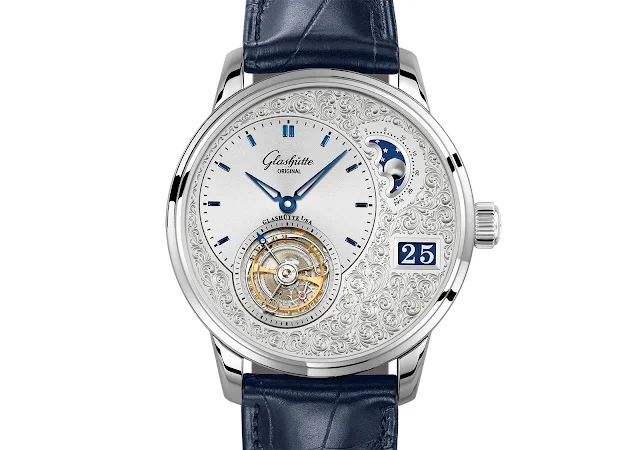the Glashütte Original PanoLunarTourbillon Limited Edition ref. 1-93-12-01-03 has a price of Euro 126,720. The Glashütte Original PanoLunarTourbillon Limited Edition ref. 1-93-12-01-03 has a price of Euro 126,720.
Limited to 25 pieces, the Glashütte Original PanoLunarTourbillon combines the technical sophistication of a flying tourbillon with an exceptional level of craftsmanship.
This special edition of the model originally introduced in 2013 (you can read about it here) is characterized by elaborate hand engravings that adorn the galvanic silver surface of the dial and the back of the movement transforming this timepiece in a pure work of art.
Both the auxiliary dial for hours and minutes and the Flying Tourbillon with small seconds are positioned on the left side of the dial. The skeletonized hour and minute hands, the indexes and the blued steel tip of the seconds hand provide contrasting accents in blue. Blue is also used on the right side for the moon phase display and the watchmaker’s signature Panorama Date.
One of the most appreciated horological feats, the tourbillon (French for whirlwind) was originally developed by Abraham Louis Breguet in 1801 to compensate for the effects of gravity on the rate precision of mechanical pocket watches. The ingenious construction compensates for the centre of gravity fault resulting from the vertical position of the watch by causing the entire oscillation and escapement system to turn on its axis once a minute.
In order to see a significant improvement to the tourbillon invented by Abraham-Louis Breguet, we had to wait more than a century when Alfred Helwig, master watchmaker and instructor at the German School of Watchmaking in Glashütte, designed the first flying tourbillon in 1920. Rather than being supported by a bridge on the dial side and a bridge on the movement side, the flying tourbillon is cantilevered, i.e. is only secured to the plate on one side so offering an unobstructed view of the mechanism on the other side.
All engravings on the dial side are executed in Glashütte Original’s own dial manufactory in Pforzheim. The engravers work without a pattern, using a burin to inscribe the design freehand in the solid gold dial blanks.
The lavishly decorated dial is framed by a 40 mm x 13.1 mm round case crafted from platinum.
Visible through the sapphire crystal case back, the automatic movement Calibre 93-12 showcases the typical features of the Glashütte movements - sunburst finish, blued screws, bevelled and polished edges - and it is further adorned by elaborate engravings.
The off-centre, skeletonized rotor has an oscillating mass in 21-carat gold. On a screw-mounted decorative stainless steel plaque, one finds the words “Flying Tourbillon” engraved and lined with gold. Beating at 21,600 vibrations per hour (3 Hz), this refined movement offers 48 hours of power reserve.
Matched to a blue Louisiana alligator leather strap with fold fastener in platinum, the Glashütte Original PanoLunarTourbillon Limited Edition ref. 1-93-12-01-03 has a price of Euro 126,720. glashuette-original.com
Suggested reading:
- The Tourbillon: history of a watchmaking feat
- Our visit to the Glashütte Original manufactory
This special edition of the model originally introduced in 2013 (you can read about it here) is characterized by elaborate hand engravings that adorn the galvanic silver surface of the dial and the back of the movement transforming this timepiece in a pure work of art.
Both the auxiliary dial for hours and minutes and the Flying Tourbillon with small seconds are positioned on the left side of the dial. The skeletonized hour and minute hands, the indexes and the blued steel tip of the seconds hand provide contrasting accents in blue. Blue is also used on the right side for the moon phase display and the watchmaker’s signature Panorama Date.
One of the most appreciated horological feats, the tourbillon (French for whirlwind) was originally developed by Abraham Louis Breguet in 1801 to compensate for the effects of gravity on the rate precision of mechanical pocket watches. The ingenious construction compensates for the centre of gravity fault resulting from the vertical position of the watch by causing the entire oscillation and escapement system to turn on its axis once a minute.
In order to see a significant improvement to the tourbillon invented by Abraham-Louis Breguet, we had to wait more than a century when Alfred Helwig, master watchmaker and instructor at the German School of Watchmaking in Glashütte, designed the first flying tourbillon in 1920. Rather than being supported by a bridge on the dial side and a bridge on the movement side, the flying tourbillon is cantilevered, i.e. is only secured to the plate on one side so offering an unobstructed view of the mechanism on the other side.
An example of Alfred Helwig's flying tourbillon - 1927
All engravings on the dial side are executed in Glashütte Original’s own dial manufactory in Pforzheim. The engravers work without a pattern, using a burin to inscribe the design freehand in the solid gold dial blanks.
The lavishly decorated dial is framed by a 40 mm x 13.1 mm round case crafted from platinum.
Visible through the sapphire crystal case back, the automatic movement Calibre 93-12 showcases the typical features of the Glashütte movements - sunburst finish, blued screws, bevelled and polished edges - and it is further adorned by elaborate engravings.
The off-centre, skeletonized rotor has an oscillating mass in 21-carat gold. On a screw-mounted decorative stainless steel plaque, one finds the words “Flying Tourbillon” engraved and lined with gold. Beating at 21,600 vibrations per hour (3 Hz), this refined movement offers 48 hours of power reserve.
Matched to a blue Louisiana alligator leather strap with fold fastener in platinum, the Glashütte Original PanoLunarTourbillon Limited Edition ref. 1-93-12-01-03 has a price of Euro 126,720. glashuette-original.com
- The Tourbillon: history of a watchmaking feat
- Our visit to the Glashütte Original manufactory




















COMMENTS